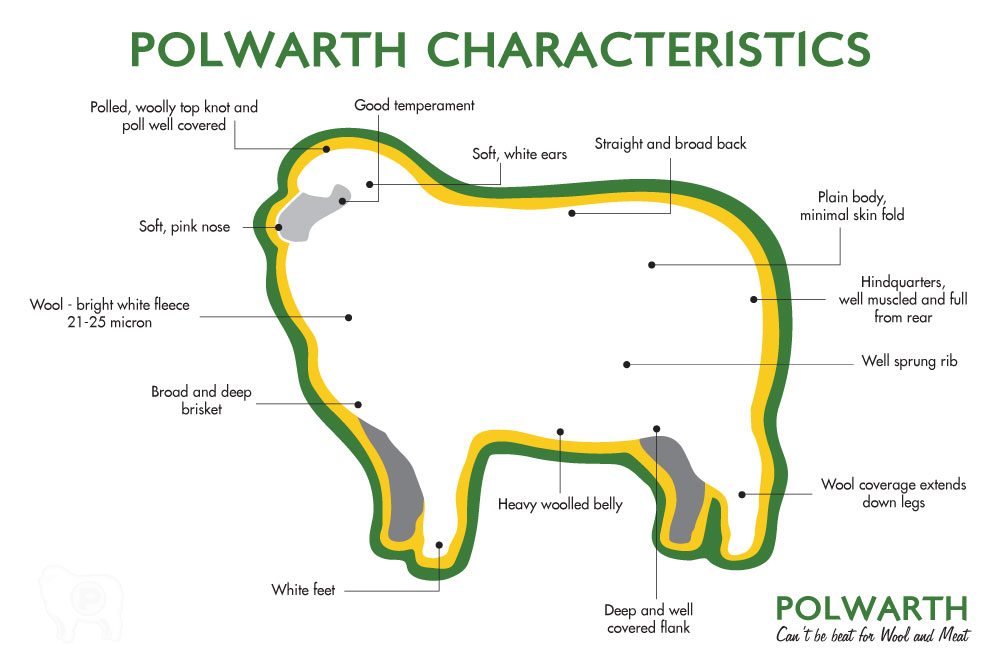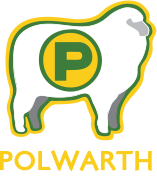Breed Characteristics
THE POLWARTH – BREED DESCRIPTION
Polwarth sheep were founded by crossing Merino and Lincoln which was then line bred to a fixed type of ¾ Merino and ¼ Lincoln. As a result, the Polwarth is a dual purpose plain bodied sheep with minimal wrinkle. They are docile in nature, making them an easy-care animal. The Polwarth grows an open, even, soft, white, high yielding fleece of 20-24 micron. The incidence of flystrike and need for mulesing is reduced due to their plain body and open fleece. When mated to Polwarth rams or terminal sires, ewes produce quality prime lambs with an excellent ratio of lean muscle to fat.
Polwarths can be found in all states of Australia. It is important to remember that flocks experience considerable variation in climate from north to south and east to west. Breeders therefore adapt their flocks to their environmental conditions.
The following guide to selecting ewes and rams should be based on conformation and wool.
CONFORMATION
Desirable Head Traits
Head
The skull is broad with good width between the ears. The head is held high.
Poll
Well covered with an even length of staple extending to the topknot. A true Poll sheep will have hollows in the head however removable buttons/scurs are acceptable.
Face
Soft white skin and clean of wool.
Eyes
Clear, bright, kind and alert. Eyelashes are white.
Ears
Thick, soft and white.
Nose
Broad, soft and free rolling, particularly on rams.
Mouth
Broad in structure. Teeth should hit the gum pad evenly.
Desirable Body Traits
Neck
Well set on shoulders with some stretch.
Back
Straight, broad and long, carrying right through to the tail.
Hindquarters
Thick, well-muscled and full from rear.
Brisket
Broad and deep.
Rib
Wide and deep. Otherwise known as the ‘engine room.’
Flank
Deep and well covered.
Girth
Straight under line with good covering of wool.
Below Tail
Width to handle the genitals or udder.
Breech
Barer breech is acceptable. In line with the industry’s move away from mulesing, breeders may select for a barer breech.
Ram Testes
Firm, even and smooth; over 30cm by 2 years of age.
Ewe Udder
Even, well formed, medium sized teats and clear of wool.
Legs
Heavy boned, set squarely. Generous covering of wool preferred, however bare below the knee and hock is acceptable.
Feet
White, evenly shaped with moderate angulation of hocks and pasterns.
Desirable Wool Traits
Fleece
- Wool is soft, bright and white despite climatic variation including cold, rain, heat, dust,
humidity and sunlight. - Character is well-defined crimp.
- Ideal micron range is 20-24. A lower micron of 19 and higher micron of 25 need not
disqualify as long as animals maintain their Polwarth attributes. - Fleece is dense. As a guide, an unskirted 12-month ewe fleece should weigh 5-8kg.
- Staple length is 100-125mm for a 12-month fleece.
- Ideal yield is 74-75%.
- In terms of micron the fleece should be as even as possible with some variation
acceptable. The breech area below the tail to the leg bone will be the broadest.
UNDESIRABLE TRAITS
Undesirable head traits
- Overshot or undershot jaw.
- Narrow nose, particularly on rams.
- Non-removable scurs, especially in stud rams. Acceptable in flock rams.
- Presence of harsh kempy fibres on the face or topknot. This may indicate harshness in
the wool on the breech and elsewhere. - Wool growing in front of the eyes, otherwise known as wool blindness.
Undesirable body traits
- Excessive body wrinkle, especially around the neck and breech areas.
- Black stripes on feet. Distortion in the shape of hooves.
- Narrow hindquarters.
- Significant hock angulation inwards or outwards.
- Trough or ridge between the shoulder blades.
Undesirable wool traits
- Coloured wool (degree of yellowness) can lead to fleece rot and flystrike problems.
- Plain wool which lacks definition and crimp.
- Dry wool or wool with too much lanolin.
- Presence of cross fibres. The fleece should open like the pages of a book.
- Presence of dark fibres. Fibre pigmentation on the face, ears, eyelashes can be an indication of dark fibres elsewhere in the wool.
- Presence of hairy fibres on the back of the neck and breech area. Also known as medullated fibres, a good time to check is 3–4 months after shearing as these fibres grow more quickly than the wool in the first few months. Also, when shearing keep the shank or sock wool separate to fleece wool. Alternatively, leave the socks on especially the front socks as they fall into the fleece wool.




